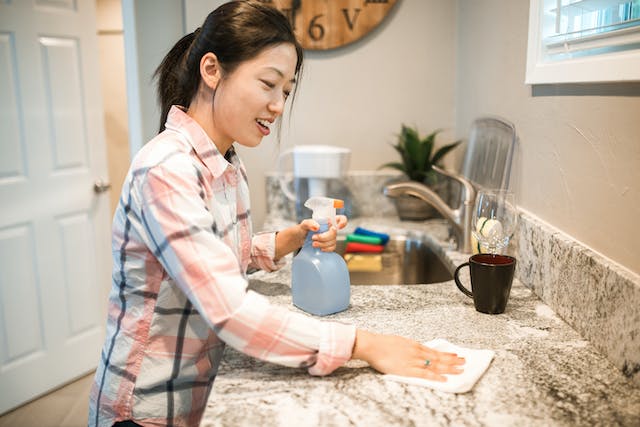Introduction:
Meet Dr. Emily Lawson, a seasoned microbiologist with over two decades of experience in the field. Dr. Lawson has dedicated her career to unraveling the mysteries of microbial life, making her the ideal guide for our journey today. we will delve deep into a common household item, kitchen disinfecting wipes, and uncover the surprising ways they may be affecting the cleanliness of your kitchen. Kitchen cleanliness is a top priority for most households. We want our cooking spaces to be hygienic, safe, and free from harmful bacteria. According to Dr. Lawson, the answer is not as straightforward as we might hope. “Disinfecting wipes can be effective, but they may not always achieve the level of cleanliness we expect in our kitchens, she explains. The effectiveness of these wipes depends on several factors, including the type of surface, the disinfectant used, and the contact time. Dr. Lawson points out that while disinfecting wipes are generally good at removing visible dirt and germs, they may not be sufficient for certain situations, especially when dealing with stubborn microbes that require a longer contact time to be killed. Many people use wipes for a quick once-over of their countertops,

Microbial Battlefield
To comprehend the effectiveness of disinfecting wipes better, we need to explore the microbial world lurking on kitchen surfaces. Dr. Lawson takes us on a journey into this microscopic battleground. Your kitchen is a microbial battlefield, teeming with microscopic life,” Dr. Lawson explains. “It’s a dynamic ecosystem where various microorganisms, including bacteria, viruses, and fungi, coexist.” Many of these microbes are harmless or even beneficial, but some can be pathogenic and pose health risks. She points out that our obsession with sterilizing every inch of our kitchens can inadvertently harm the beneficial microbes, which play a role in maintaining a balanced microbial ecosystem.
Wipe-Down Dilemma
The quest for a spotless kitchen might lead to an unintended consequence: overuse of disinfecting wipes. Dr. Lawson highlights the importance of striking a balance between cleanliness and preserving microbial diversity. In our pursuit of a squeaky-clean kitchen, we may be overusing disinfecting wipes, believing that more is better, she cautions. “But excessive use of these wipes can disrupt the delicate equilibrium of your indoor microbial community. Dr. Lawson suggests a more targeted approach to cleaning. “Instead of a daily wipe-down, consider using disinfecting wipes when necessary, such as after handling raw meat or when someone in your household is ill. She emphasizes the need for occasional deep cleaning and using eco-friendly cleaning alternatives to avoid over-reliance on disinfectants.

Hidden Harms
Beyond the kitchen, there are broader environmental consequences to consider when it comes to excessive wipe usage. Disposable disinfecting wipes are often non-eco-friendly and contribute to waste. Dr. Lawson sheds light on this hidden harm. “Disposable disinfecting wipes are a convenient but wasteful choice,” she states. They come in single-use packaging and are often made from materials that do not decompose easily, contributing to environmental pollution. The production, packaging, and disposal of these wipes have significant carbon footprints. Moreover, the chemicals in the wipes can potentially leach into the environment, affecting water quality and wildlife. Our commitment to a clean and safe kitchen should extend to a broader environmental responsibility,” Dr. Lawson emphasizes.
KeyPoint:
| Aspect | Disinfecting Wipes | Eco-Friendly Alternatives |
|---|---|---|
| Effectiveness | Often effective, but not 100% | Effective, with natural ingredients |
| Microbial Impact | May reduce microbial diversity | Supports a healthier microbial environment |
| Environmental Consequences | Non-eco-friendly, disposable | Environmentally responsible, sustainable |
| User-Friendliness | Convenient, but wasteful | Sustainable, user-friendly |
| Cost | Moderate | Varies, but often cost-effective. |
Conclusion:
The pursuit of a clean and safe kitchen is a goal shared by many, but the means to achieve it deserve a second look. Dr. Emily Lawson’s insights into kitchen disinfecting wipes and their impact on cleanliness, microbial diversity, and the environment offer a fresh perspective on our cleaning habits. Disinfecting wipes are undoubtedly effective in many cases, but they may not always deliver the level of cleanliness we desire, especially when faced with stubborn microbes that require more contact time to be eliminated. Dr. Lawson reminds us that thorough cleaning, including pre-cleaning and following disinfectant instructions, is vital for optimal results. Our kitchens are, in reality, dynamic microbial ecosystems. While we strive to eliminate harmful microorganisms, it’s equally important to preserve the beneficial microbes that contribute to a balanced indoor microbiome. Overusing disinfecting wipes can disrupt this balance, potentially leading to unintended consequences. The environmental impact of disposable wipes cannot be ignored. They contribute to waste and pollution, both in their production and disposal. Choosing eco-friendly cleaning alternatives is a responsible step, promoting both a cleaner kitchen and a healthier planet. These alternatives often use natural ingredients and reduce the environmental footprint associated with disposable wipes.




